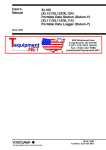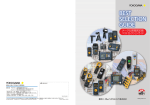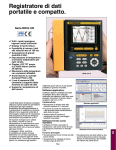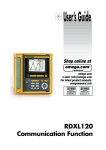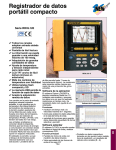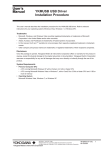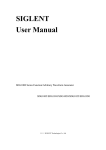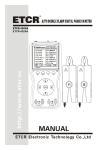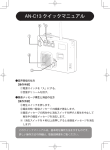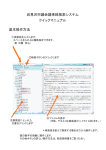Download User`s Manual
Transcript
User's Manual XL100 Datum-Y IM XL120P クイックマニュアル Quick Setup Manual XL111, XL112, XL114 ポータブルデータロガ−(Datum-Y) XL121, XL122, XL124 ポータブルデータステーション(Datum-Y) XL111, XL112, XL114 Portable Data Logger (Datum-Y) XL121, XL122, XL124 Portable Data Station (Datum-Y) IM XL120P 1st Edition: Apr. 2007(YMI) Introduction Thank you for purchasing our XL100 Portable Data Station/Portable Data Logger. This Quick Setup Manual briefly describes the key operations as well as setting examples of the XL100 upon actual measurement, so that you can operate the XL100 for the first time. In addition to this manual, the User’s Manual and Communication Function Manual contained in the CD-ROM are available separately. The User’s Manual provides detailed information regarding all of the functions and operations of the XL100 excluding the communication functions. The Communication Function Manual provides information necessary for using communication functions and creating communication programs. Use them together with this Quick Setup Manual. The Communication Function Manual is available only for the Portable Data Station. After reading this manual, keep it in an easily accessible place for later reference. This manual will come in handy when you are unsure of how to operate the product. Notes • The contents of this manual are subject to change without prior notice. • Figures and illustrations representing display views in this manual may differ from actual views. • Every effort has been made to ensure accuracy in the preparation of this manual. However, should any doubts arise or errors come to your attention, please contact the vendor from which you purchased the product. • The contents of this manual may not be transcribed or reproduced, in part or in their entirety, without prior permission. Trademarks The company and product names referred to in this document are either trademarks or registered trademarks of their respective holders. Revisions First Edition: April, 2007 1st Edition: April 2007 (YMI) All Rights Reserved, Copyright © 2005, Yokogawa Meters & Instruments Corporation IM XL120P 1 Safety Precautions When operating the instrument, be sure to observe the cautionary notes given in “Safety Precautions” on pages 4 and 5 and section 3.1, “Handling Precautions” in the User’s Manual. If you use the instrument in any way other than as instructed, the instrument’s protective measures may be impaired. The following safety symbols are used on the instrument and in this manual. WARNING Indicates a hazard that may result in the loss of life or serious injury of the user unless the described instruction is abided by. CAUTION Indicates a hazard that may result in an injury to the user and/or physical damage to the product or other equipment unless the described instruction is abided by. Note Indicates information that is essential for handling the instrument or should be noted in order to familiarize yourself with the instrument’s operating procedures and/or functions. TIP Indicates information that complements the present topic. 2 IM XL120P Contents Introduction ............................................................................. 1 Safety Precautions .................................................................. 2 1. Checking the Contents of the Package ........................ 4 2. Flow of Operation ........................................................... 5 3. Names and Functions of Parts ...................................... 6 4. How to View the Display ................................................. 9 5. Introduction of the Main Functions ............................. 15 Input Type and Calculation .................................................................. 15 Alarm Function ..................................................................................... 16 Saving Data ........................................................................................... 17 Triggers ................................................................................................. 18 File Operations ..................................................................................... 18 Communication Function .................................................................... 19 6. Operation Mode and Basic Key Operations ............... 21 Operation Modes and Switching the Operation Mode ...................... 21 Switching the Display in Free Running Mode or Logging Mode ...... 22 Switching the menu in Setting Mode .................................................. 22 Key Operations for Entering Characters ............................................ 23 Key Operations for Entering Values .................................................... 23 7. 8. Signal Wiring ................................................................. 24 Connecting to the Power Supply and Turning the Power Switch ON/OFF .................................................. 26 Connecting the Power Supply ............................................................. 26 Turning the Power Switch ON/OFF ..................................................... 27 9. Setting the Input Channel ............................................ 29 10. Setting the Data Save Operation ................................. 33 11. Confirming the Settings and Performing the Measurement ............................................................................... 38 12. Inserting an External Storage Medium and Saving Data . 39 Inserting an External Storage Medium ............................................... 39 Starting the Data Save Operation ....................................................... 40 Stopping the Data Save Operation ..................................................... 40 13. Analyzing the Saved Data ............................................ 41 Loading the Saved Data File ................................................................ 41 Loading the Measured Data ................................................................. 43 Displaying Statistical Calculation Values ........................................... 43 IM XL120P 14. Troubleshooting ............................................................ 44 Index ....................................................................................... 45 3 1. Checking the Contents of the Package Unpack the box and check the contents before operating the instrument. Should the product you have received be the wrong model, lack any items, or show any problems in its appearance, contact the vendor from whom you purchased the product. Instrument Main Unit Check the model and suffix code printed on the nameplate on the rear panel to ensure that the XL100 is exactly as specified in your purchase order. Model XL100 No. When inquiring about the product to the vender, please also give the vendor this number. Accessories Make sure that the package contains all the accessories listed below and that they are all free from any damage. These are attached to the XL100. Terminal block unit Rubber boot Screwdriver for terminals + ch -1 b + ch -2 b + ch -3 b + ch -4 b + ch -5 b + ch -6 b + ch -7 b + ch -8 1. (Ex.: 95052) Side cover (Supplied with the XL121, XL122, and XL124) AC adapter Quick setup manual (this manual) CD-ROM Contains Standard Software and PDF manuals (User's Manual, Quick Setup Manual, and Communication Function Manual). TIP For details on peripherals and spare parts, see page 3 in the User’s Manual. 4 IM XL120P 2. Flow of Operation Reference page in this manual Reference chapter/ section in the User’s Manual Connect the wires Page 24 3.3-3.5 Connect the power supply and turn the power ON Page 26 3.6, 4.1 Set the language Page 28 Configure Initial startup only • Set the input Page 29 Chapter 5 • Save the data Page 33 9.1 Set other items (as necessary) • • • • • • Alarm Display Calculation Communications Hardware System Chapter 6 Chapter 7 Chapter 8 Chapter 10 Chapter 4, 11, etc. 11.6, 11.7 Confirm the settings Free Running Mode and measure Page 38 Save the data Page 39 9.1 Page 41 • Review Mode • Logging & Review Mode 9.2 Analyze the data Logging Mode Process the file (as necessary) • Rename the file • Delete the files • Copy the data IM XL120P 9.7 9.8 9.9 5 3. Names and Functions of Parts Front Panel Terminal block unit Display Terminal block unit where probes are connected. For the wiring procedure, see page 23. Displays measured data, operation status, setup menu, settings, etc. For the viewing the displays, see page 9. Status display section Data display, setting menu, and setting display section HOME REVIEW FILE TIME / DIV SETTING HOLD SET ESC START / STOP RANGE DISPLAY SAVE GROUP SELECT MARK Keys Operation status LED POWER : Illuminates when the power is ON CHARGE : Illuminates when the battery is being charged START : Illuminates while logging Keys 4 3 2 1 HOME REVIEW FILE 6 9 TIME / DIV START / STOP SETTING HOLD 7 5 SET ESC 10 RANGE DISPLAY 12 SAVE GROUP 8 11 13 SELECT MARK 14 6 15 16 IM XL120P 3. Names and Functions of Parts 1. HOME Key Press this key to enable Free Running Mode for measuring instantaneous values (see page 21). 2. REVIEW Key Press this key to enable Logging & Review Mode in which past measured data can be viewed while logging (see page 21) or enable Review Mode in which saved data can be analyzed (see page 21). 3. FILE Key Press this key to enable File Operation Mode in which file names can be changed, measured data can be copied, setting data can be saved or loaded, and so on (see page 21). 4. SETTING Key Press this key to set measurement conditions, conditions for saving measured data, alarm conditions, etc. 5. HOLD Key Press this key to hold the display so that the measured values are not updated or to release the display. In addition, hold this key down to enable or disable key lock. 6. TIME/DIV Key Press this key to switch the time axis (the time per grid (division)). 7. ESC Key Press this key to cancel a key operation. 8. SET Key Press this key to set settings entered through the keys. 9. START/STOP Key Press this key to start/stop logging. 10. RANGE Key Press this key to change the input range or span (scale). 11. DISPLAY Key Press this key to switch the display in Free Running Mode or Logging Mode (see page 22). Press this key also to switch between marker display and statistical calculation display in Review Mode. 12. SAVE Key Press this key to manually save or print the measured data or screen data. 13. GROUP Key Press this key to switch the displayed group of measurement, calculation, and communication input channels. 14. Fast Forward Key Press this key to move the marker to the left or right by 1 division on the review display (see page 43). 15. MARK Key Press this key to select a marker to be activated on the review display (see page 43). 16. Arrow/SELECT Key Press the arrow keys to select items on the display. Press this key also to move the marker to the left or right on the review display (see page 43). Press the SELECT key to confirm a selection. IM XL120P 7 3. Names and Functions of Parts Side Panel USB port for USB memory For a description, see section 3.9. Ethernet port* CF card slot For a description, see section 3.8. USB port for connecting a PC* For a description, see section 4.7. SD card slot* For a description, see section 3.8. USB The reference sections are those of the User’s Manual. For a description, see section 4.7. For details on how to insert the CF card or SD card, see page 39. USB DC INPUT 12V 20W MAX CF SG SD IN GND OUT LOGIC/PULSE POWER LAN Power switch For a description, see section 4.1. AC adapter jack For a description, see section 3.6. For details on connecting the power supply and turning the power ON/OFF, see pages 26 and 27. RS485 RS232 ALARM TRIGGER Trigger input/output terminal For a description, see section 3.5. Digital I/O connector For a description, see section 3.4. RS-232 connector* For a description, see section 3.8. RS-485 connector* For a description, see section 3.8. * Supported only on the XL121, XL122, and XL124 Rear Panel Screwdriver for terminals (accessory) Press the screwdriver towards the spring (right in this figure) to detach it. Name plate Battery cover Holds the lithium ion battery (94009) sold separately . 8 IM XL120P 4. How to View the Display Status Display Section 3 2 1 7 4 5 6 8 1. Operation Mode Displays the mode: Free Running, Logging, Logging & Review, Setup, or File Operation. 2. User name Displays the login user name when the key login function (see section 11.7 in the User’s Manual) is turned ON. 3. Group Name (For the procedure to set groups, see section 7.2 in the User’s Manual) Displays the group name of the displayed measurement channel. 4. Alarm Status (For a description of the alarm function, see page 16) The status is displayed using different icon colors as follows: Gray: Yellow-green: Red: No alarm setting Alarm setting enabled Alarm activated 5. Alarm Output Status The status is displayed using different icon colors for each alarm output channel (1 to 4) as follows: Gray: Yellow-green: Red: No alarm setting Alarm setting enabled Alarm outputting 6. Date/Time (For the procedure to set the date/time, see section 4.3 in the User’s Manual) Displays the year, month, day, hour, minute, and second. 7. Sampling Interval Displays the sampling interval (measurement/save interval of measured data) when in Free Running, Logging, or Logging & Review Mode. 8. Various Icons The following icons are used to display the operation status, interface usage status, etc. An icon shown when the data save destination is set to internal memory. The icon blinks when there is access to the internal memory. The icon is gray when the data save destination is not set to internal memory. IM XL120P 9 4. How to View the Display An icon shown when the data save destination is set to internal memory and the save mode is set to DIVISION. The icon blinks when there is access to the internal memory. An icon shown when the data save destination is set to internal memory and the memory full operation is set to REPEAT. The icon blinks when there is access to the internal memory. An icon shown when the data save destination is set to internal memory and the memory full operation is set to DELETE. The icon blinks when there is access to the internal memory. An icon shown when the data save destination is set to internal memory, the save mode is set to DIVISION, and the memory full operation is set to REPEAT. The icon blinks when there is access to the internal memory. An icon shown when the data save destination is set to internal memory, the save mode is set to DIVISION, and the memory full operation is set to DELETE. The icon blinks when there is access to the internal memory. An icon shown when the data save destination is set to CF card. The icon blinks when there is access to the CF card. The icon is gray when the data save destination is not set to CF card. An icon shown when the data save destination is set to CF card and the save mode is set to DIVISION. The icon blinks when there is access to the CF card. An icon shown when the data save destination is set to CF card and the memory full operation is set to REPEAT. The icon blinks when there is access to the CF card. An icon shown when the data save destination is set to CF card and the memory full operation is set to DELETE. The icon blinks when there is access to the CF card. An icon shown when the data save destination is set to CF card, the save mode is set to DIVISION, and the memory full operation is set to REPEAT. The icon blinks when there is access to the CF card. An icon shown when the data save destination is set to CF card, the save mode is set to DIVISION, and the memory full operation is set to DELETE. The icon blinks when there is access to the CF card. An icon shown when the data save destination is set to SD card. The icon blinks when there is access to the SD card. The icon is gray when the data save destination is not set to SD card. (Supported only on the XL121, XL122, and XL124.) An icon shown when the data save destination is set to SD card and the save mode is set to DIVISION. The icon blinks when there is access to the SD card. (Supported only on the XL121, XL122, and XL124.) An icon shown when the data save destination is set to SD card and the memory full operation is set to REPEAT. The icon blinks when there is access to the SD card. (Supported only on the XL121, XL122, and XL124.) 10 IM XL120P 4. How to View the Display An icon shown when the data save destination is set to SD card and the memory full operation is set to DELETE. The icon blinks when there is access to the SD card. (Supported only on the XL121, XL122, and XL124.) An icon shown when the data save destination is set to SD card, the save mode is set to DIVISION, and the memory full operation is set to REPEAT. The icon blinks when there is access to the SD card. (Supported only on the XL121, XL122, and XL124.) An icon shown when the data save destination is set to SD card, the save mode is set to DIVISION, and the memory full operation is set to DELETE. The icon blinks when there is access to the SD card. (Supported only on the XL121, XL122, and XL124.) An icon shown when there is data saved in the backup memory. The icon blinks when there is access to the backup memory. The icon is gray when there is no data saved to the backup memory. An icon shown when the interface is set to LAN, LAN/RS-232, or LAN/RS-485. For other cases, the icon is gray. (Supported only on the XL121, XL122, and XL124.) An icon shown when the interface is set to USB. For other cases, the icon is gray. (Supported only on the XL121, XL122, and XL124.) An icon shown when the communication protocol is set to Modbus (slave). The icon is gray when set to Modbus (master). (Supported only on the XL121, XL122, and XL124.) An icon shown when the communication protocol is set to Modbus (master). The icon is gray when set to Modbus (slave). (Supported only on the XL121, XL122, and XL124.) An icon shown when the printer output is turned ON and the sampling interval is greater than or equal to 1 minute. The icon is gray when the printer output is OFF. (Supported only on the XL121, XL122, and XL124.) An icon shown when the printer output is turned ON and the sampling interval is less than or equal to 30 seconds. This indicates that only manual print is valid using the SAVE key. (Supported only on the XL121, XL122, and XL124.) An icon shown when the display update is held. The icon is gray when the display is not held. An icon shown when key lock is enabled. The icon is gray when key lock is disabled. An icon shown when the AC adapter is connected. An icon shown when the AC adapter is not connected, and the XL100 is running on a battery. Shows the remaining battery power using four levels ( IM XL120P → → → ). 11 4. How to View the Display Data Display Section Waveform & Digital Display 1 3 4 2 6 12 10 11 8 5 9 7 1. Waveform Waveforms of measured data, calculated data, and communication input data. Waveforms of logic input are shown at the lower section of the screen as shown in the figure above. 2. Time Axis Displays the time axis (time per grid (division)) specified by the TIME/DIV key. 3. Alarm Line Displayed with a dotted line at the position of the alarm value of the selected channel (active channel). 4. Scale Upper Limit Shows the display upper limit of the active channel. 5. Scale Lower Limit Shows the display lower limit of the active channel. 6. Pen Displayed at the current value position of each channel. The active channel is shown highlighted in reverse video. 7. Usage Indication Bar of the Storage Media Displays using a blue bar the amount of space used with respect to the total space on the storage medium that is specified to be the save destination of the measured data. Total space on the save destination medium Used space Free space 8. Grid The grid can be turned ON/OFF. 12 IM XL120P 4. How to View the Display 9. Elapsed Time Displays the elapsed time from the start of the logging operation. 10. Digital Display Displays the current values of the measured data, calculated data, and communication input data using numeric values.When an alarm is occurring, the value is shown in red in reverse video. 11. Unit Displays preset characters such as °C or an arbitrary specified characters (up to 6 characters). 12. Channel No./Tag Displays the channel number and the specified tag (up to 8 characters). The active channel is shown highlighted (reverse video). Other Data Displays In addition to the waveform & digital display, other displays are available including the waveform display that does not show numeric values. For a description of the data displays below, see section 2.3, “Data Display” in the User’s Manual. • Digital Display Displays the numeric values of the instantaneous values and statistical calculation values. • Bar Graph Display Displays a bar graph in place of a waveform. IM XL120P 13 4. How to View the Display • Review Display Displays the waveforms of data saved in the past. • Logging & Review Display Displays both the waveforms of data currently being logged and the waveforms of data saved in the past. • Alarm Summary Display Displays the alarm status in a list. • Log Display Displays the log data of error messages and communications. 14 IM XL120P 5. Introduction of the Main Functions Input Type and Calculation As shown in the table below, the available input types are analog input, which includes DC voltage, thermocouple, and RTD, and other inputs, which consist of pulse signal (1 channel) and logic signals (2 channels). In addition, the arithmetic calculations between two inputs can be performed and assigned to a calculation channel and displayed in the same fashion as measured values. The statistics of measured values can also be displayed. For details on the input settings, see chapter 5, “Setting the Input Channels.” For details on calculation, see chapter 8, “Setting the Calculation of Measured Data.” Input/Calculation Description DC voltage Measures a DC voltage in the range of ±100 mV to ±50 V. Thermocouple Selectable from the following types: R, S, B, K, E, J, T, N, W, L, and U. RTD Selectable from Pt100 and JPt100 types. Pulse signal Displays the pulse input as number of revolutions, integrated value, or instantaneous value. Logic signal Displays the logic waveform at the lower section of the display by taking input voltage less than or equal to 0.9 V to be OFF (0) and input voltage greater than or equal to 2.1 V to be ON (1). Calculation Performs arithmetic calculations using measured data, calculated data, communication data, and arbitrary assigned constants and displays the result. Statistical calculation Calculates and displays the maximum, minimum, average, peak (P-P), or rms value of the measured value. Displays the measured/calculated data Signal input Voltage Thermocouple Pulse/Logic input RTD TIP You must connect a digital I/O cable sold separately to the input terminal (digital I/O connector) to apply pulse or logic signals. (See section 3.4 in the User's Manual.) IM XL120P 15 5. Introduction of the Main Functions Alarm Function Generates an alarm when the measured/calculated value meets a certain condition. When an alarm occurs, information notifying the alarm occurrence is displayed on the screen. In addition, an alarm signal can be delivered from the output terminal (digital I/O connector) on the rear panel of the XL100 by connecting a digital I/O cable (option). You can select the alarm conditions from the following table. For details on the settings, see chapter 6, “Setting Alarms” in the User’s Manual. Input Type Setting Alarm Condition Level or Pulse OFF Hi Not set alarm conditions. An alarm occurs when the measured/calculated value is greater than or equal to the alarm value. An alarm occurs when the measured/calculated value is less than or equal to the alarm value. An alarm occurs when the measured/calculated value is within the lower limits and upper limits of the alarm range. An alarm occurs when the measured/calculated value is outside the lower limits and upper limits of the alarm range. Lo Window IN Window OUT Logic OFF Hi Not set alarm conditions. An alarm occurs when the logic input changes from low to high. An alarm occurs when the logic input changes from high to low. Lo Lo Hi Alarm value Alarm occurrence Measured Alarm release value Alarm release Alarm value Alarm occurrence Measured value Window OUT Window IN Alarm value Alarm occurrence Alarm release Measured value 16 Measured value Alarm occurrence Alarm release Alarm value IM XL120P 5. Introduction of the Main Functions Saving Data Measured data, calculated data, setting data, and so forth can be saved to the XL100 internal memory or an external storage medium (CF card or SD card) that is inserted in the XL100. Save the data CF SD Supported only on the XL121, XL122, and XL124 TIP The XL100 is equipped with a USB port for USB memories. However, data cannot be saved directly to a USB memory (see section 3.9 in the User’s Manual). The types of data that can be saved are as follows: Type Description Logging data The instantaneous values of the measured/calculated data can be saved at a specified sampling interval. The data save operation is started or stopped with the START/STOP key. The save operation can also be started or stopped when a specific event (see “Trigger” on the next page) occurs. The logging data contains alarm information. Manual sampled data The measured/calculated data (instantaneous values) of all channels can be saved by pressing the SAVE key in Free Running Mode. Alarm data The same information as the alarm summary display can be saved by pressing the SAVE key during alarm summary display. Screen image data The image data of the screen being displayed can be saved by pressing the SAVE key in Free Running Mode, etc. Setting data The setting data of the XL100 can be saved in File Operation Mode. Log data The same information as the log display can be saved by pressing the SAVE key during log data display. Backup file If the data save operation is not carried out normally to the internal memory or external storage medium (CF card or SD card), the data is saved to the backup memory of the XL100. The saved data can be copied to an external storage medium. IM XL120P 17 5. Introduction of the Main Functions Triggers In addition to using the START/STOP key to start or stop the logging, a trigger for starting (or stopping) the save operation of the logging data (measured/ calculated data) can be configured for automatic operation. The trigger for logging can be selected from the list below and configured. Type Description None Not set trigger conditions. External A trigger is activated when a signal is applied to the external trigger input terminal. Level High limit (H) Low limit (L) Window IN Window OUT Alarm A trigger is activated when the measured value is greater than or equal to the specified value. A trigger is activated when the measured value is less than or equal to the specified value. A trigger is activated when the measured value is within the specified lower and high limits. A trigger is activated when the measured value is outside the specified lower and high limits. A trigger is activated when an alarm occurs on the specified alarm output channel. Time A trigger is activated at the specified time. Timer The time at which the data save operation is stopped can be specified. Logging is stopped after the specified time elapses. File Operations The following file operations are available. Operation Type Description Rename Renames files saved on an external storage medium (CF card or SD card) or internal memory. Save setting data Saves setting data to an external storage medium (CF card, SD card, and USB memory), internal memory, or setting memory. Load setting data Loads the setting data saved on an external storage medium (CF card, SD card, and USB memory), internal memory, or setting memory and changes the settings. Copy data Copies the files saved to the an external storage medium (CF card or SD card), internal memory, or setting memory to an external storage medium (CF card, SD card, or USB memory), internal memory, or setting memory. Copy backup memory Copies the files saved to the backup memory (memory to which data is saved when data cannot be saved to an external storage medium or internal memory) to an external storage medium (CF card or SD card) or internal memory. Format 18 Formats an external storage medium (CF card or SD card), backup memory, or internal memory. IM XL120P 5. Introduction of the Main Functions Communication Function (Supported only on the XL121, XL122, and XL124) FTP Client/Server The Ethernet interface can be used to automatically transfer measurement data files to an FTP server connected to the network or access the XL100 from a PC through FTP to retrieve data on the external storage medium or internal memory of the XL100. Automatically save measured data FTP client Ethernet Hub Hub FTP server Load measured data FTP server Ethernet Hub Hub PC Web Server By configuring the XL100 to be a Web server, the XL100 screen can be shown on the PC. You can monitor the measured data and switch the display from the PC. Monitor the measured data Ethernet Web server Hub PC Hub Monitor the measured data PC IM XL120P 19 5. Introduction of the Main Functions E-mail transmission An e-mail can be sent automatically from the XL100 when an alarm occurs. Receive e-mail Ethernet Send e-mail Hub PC Hub Receive e-mail PC Serial Communication The USB interface or serial interface can be used to change the XL100 settings from a PC or retrieve data into the PC through command communication. In addition, Modbus communication is possible on the serial interface. The Modbus master function enables the measured data of a measuring instrument connected as a Modbus slave to be retrieved as communication input data. The data can be assigned to a communication channel and displayed on the XL100 in a similar fashion to measurement and calculation channels. Change settings and load data Command communication PC USB, RS-232, RS-485 Modbus master Modbus slave Modbus communication RS-232, RS-485 Measurement instrument For details on the communication functions, see the Communication Function Manual (contained in the CD-ROM). 20 IM XL120P 6. Operation Mode and Basic Key Operations Operation Modes and Switching the Operation Mode As shown in the figure below, the XL100 has six operation modes: (1) Free Running Mode in which instantaneous values are measured, (2) Logging Mode in which continuous measurement is performed while saving data, (3) Logging & Review Mode in which past measured data can be viewed while the logging operation is in progress, (4) Review Mode in which saved data is analyzed, (5) File Operation Mode in which file operations such as saving and loading of the setup data is performed, and (6) Setting Mode in which various settings such as the measurement conditions are specified. The keys in the figure below are used to switch between these modes. HOME REVIEW Free Running Mode Waveform Switch the display Digital Bar graph Alarm summary Log System information START / STOP Review Mode Marker measurement FILE SETTING File Operation Mode Setting Mode File operation menu Set Select Rename files Delete files Setup file Copy data files Copy backup memory Format Logging Mode Setting menu Statistical calculation Initialize log Select Set Input Display Data Save Alarm Calculation Communication Hardware System Waveform Switch the Digital display Bar graph Alarm summary Log System information REVIEW Logging & Review Mode Marker measurement Statistical calculation IM XL120P 21 6. Operation Mode and Basic Key Operations Switching the Display in Free Running Mode or Logging Mode To switch to a display other than waveform & digital display, press DISPLAY to show the display switch pop-up menu, select the display using the arrow keys, and press SELECT. Select the display Confirm the display Display the menu SELECT DISPLAY Switching the menu in Setting Mode Press the arrow keys to select the desired item, and press SELECT. A selection list, a setting window, or a setting menu that is one level lower is displayed. To return to the original setting menu, press ESC. Select the setup item Confirm the setup item SELECT ESC 22 IM XL120P 6. Operation Mode and Basic Key Operations Key Operations for Entering Characters For settings that require characters to be entered, a character entry window opens as shown below. To enter a character, press the arrow keys to move the cursor in the character selection area, select the character, and press SELECT. To set the entered value, press SET. Character entry area Character selection area Backspace Delete Character type selection area (A: alphabet characters. 0: numeric characters and symbols) Key Operations for Entering Values For settings that require a value to be entered, a value entry window opens as shown below. Press the up and down arrow keys to increment or decrement the value and the left and right arrow keys to move along the digits. To set the entered value, press SET. The window will not close when you press SET if a value outside the range is entered. Enter a value within the range. IM XL120P 23 7. Signal Wiring Signal Input Wiring (for Clamp Screws) Be sure to also read the precautions in section 3.3, “Wiring the Input Signal Cable” in the User’s Manual when wiring cables. CAUTION Do not apply an input exceeding the following values. Otherwise, the XL100 may break down. • Maximum input voltage 100 mV, 500 mV, and 1 V range and TC input: ±10 VDC 5 V, 10 V, 50 V, and 1-5V/f.s. range: ±60 VDC • Maximum common mode noise voltage 30 VACrms (50/60 Hz) or ±60 VDC Wiring Procedure 1. Open the terminal cover of the terminal block unit. 2. Wire the input signal cables to the input terminals. As shown below, loosen the terminal screws using the screwdriver provided, insert the signal wires, and fasten the terminal screws. 3. Close the terminal cover of the terminal block unit. Terminal cover Accessory screwdriver for terminals Enlarged view Signal wire Terminal block unit TIP The terminal block unit can be removed. For the procedure to remove the terminal block unit, see section 3.3, “Wiring the Input Signal Cable” in the User’s Manual. 24 IM XL120P 7. Signal Wiring Wiring Diagram Use wires of the following specifications. TC input DC voltage input – ch – ch – + + + + DC voltage input – b b Extension leadwire RTD input A + B ch – DC current input b b A B + + + b – – b Lead wire resistance per wire of 10 Ω or less. Make the resistance of the three wires equal. ch – DC current input Shunt resistor Example: For 4 to 20 mA input, use a shunt resistor of 250 Ω ± 0.1%. Note • For clamp terminals, use wires of the following specifications. • Conductive cross-sectional area for single wire: 0.14 mm2 to 2.5 mm2, stranded wire: 0.14 mm2 to 1.5 mm2 AWG: 26 to 14 • Length of the stripped section of the wire: Approx. 7 mm Input signal wires whose diameter is 0.3 mm or less may not be securely fastened. Fold over the conducting section of the wire, for example, to make sure that the wire is securely fastened to the clamped terminal. • RTD input terminals A (+) and B (–) are isolated on each channel. Terminal b is shorted internally across all channels. Other Wiring • For a description of the pulse input, logic input, and alarm output wiring, see section 3.4, “Wiring the Pulse Input, Logic Input, and Signal Cables” in the User’s Manual. • For a description of the external trigger input/output wiring, see section 3.5, “Wiring the External Trigger I/O Signal Cables” in the User’s Manual. IM XL120P 25 8. Connecting to the Power Supply and Turning the Power Switch ON/OFF Connecting the Power Supply Be sure to also read the precautions in section 3.6, “Connecting the Power Supply” in the User’s Manual when connecting the power supply. WARNING • Use only the power cord and AC adapter supplied by YOKOGAWA Meters & Instruments for the XL100. • Check that the power source voltage matches the supply voltage rating (100 to 240 VAC), and then connect the power cord. Connecting the AC Adapter Follow the steps below to connect the AC adapter. 1. Check that the power switch is OFF. 2. Connect the AC adapter to the AC adapter jack of the XL100. 3. Connect the plug of the power cord supplied with the AC adapter to the power connector of the AC adapter. 4. Connect the other end of the power cord to the power outlet that meets the power rating (requirements). Power supply rating of the AC adapter Supply voltage rating 100 to 240VAC Allowable supply voltage range 90 to 264 VAC Power supply frequency rating 50/60 Hz AC adapter jack 2. Connect. 4. Connect. 1. Check that the power is OFF. Power cord AC adapter 3. Connect. 26 IM XL120P 8. Connecting to the Power Supply and Turning the Power Switch ON/OFF Turning the Power Switch ON/OFF The power switch is located on the right side panel of the XL100. To turn the power ON, press the I (ON) side of the power switch. Press the O on the other side to turn the power OFF. Power switch Power Switch Operation When the Side Cover Is Attached (Supported only on the XL121, XL122, and XL124) You can operate the power switch with the rubber boot and side cover attached by opening the power switch cover. When attaching the accessory side cover, fasten the side cover attachment screw to fix the cover to the XL100. Side cover attachment screw Open from this end. Side cover Power switch cover Rubber boot Display at Power ON When the power is turned ON, the XL100 shows the startup screen followed by the self-test screen. When the self-test completes normally, the XL100 shows “Self Test OK” followed by the Waveform & Digital display of Free Running Mode. For the corrective action when an error message is displayed, see section 4.1, “Turning ON/OFF the Power Switch” in the User’s Manual. IM XL120P 27 8. Connecting to the Power Supply and Turning the Power Switch ON/OFF Language Setting at Startup When you start up the XL100 for the first time (the first time you turn on the XL100 after purchase), you must set the language that you are going to use. Follow the procedure below to set the language. Once you set the language, the XL100 will start up using the specified language the next time. 1. When you turn the power switch ON, the following screen appears. 2. Use the arrow keys to select the language, and press SELECT. 3. The language is set, and a self-test starts automatically. TIP To change the language once you set it, press SETTING, select HARDWARE > LANGUAGE, and change the setting. 28 IM XL120P 9. Setting the Input Channel This chapter explains the steps to set the input channel using an example in which a thermocouple (type E, measurement range: 0.0 to 1000.0°C) is input to CH1. The settings of other input channels are not changed from the default settings. For details on setting the input channels, see chapter 5, “Setting the Input Channels” in the User’s Manual. Keys 1. Display SETTING Change to Setting Mode. 2. SELECT Show the INPUT menu. 3. SELECT Show the ANALOG INPUT setting screen. 4. Move the cursor to CH01. IM XL120P 29 9. Setting the Input Channel Keys Display 5. SELECT Show the CH01 setting screen. 6. Move the cursor to MODE. 7. SELECT Show the MODE selection list. 8. Move the cursor to TC. 9. SELECT Select TC. 30 IM XL120P 9. Setting the Input Channel Keys Display 10. Move the cursor to RANGE. 11. SELECT Show the RANGE selection list. 12. Move the cursor to E. 13. SELECT Select E. 14. Move the cursor to SPAN LOWER. IM XL120P 31 9. Setting the Input Channel Display Keys 15. SELECT Show the SPAN LOWER entry window. 16. Enter 0.0. 17. SET Set SPAN LOWER settings. 18. SET The changed settings are confirmed. • To perform measurement: • To configure other settings: 32 HOME SETTING IM XL120P 10. Setting the Data Save Operation This chapter explains the steps to save measured data using an example in which the sampling interval is set to 1 min, the data save destination is set to CF card, and the end trigger is set to timer (seven days later). The settings for saving other measured data are not changed from the default settings. For details on the settings for saving measured data, see section 9.1, “Setting the Save Operation of Measured and Calculated Data” in the User’s Manual. Keys 1. Display SETTING Change to Setting Mode. 2. Move the cursor to DATA SAVE. 3. SELECT Show the DATA SAVE setting screen. 4. SELECT Show the SAMPLING INTERVAL selection list. IM XL120P 33 10. Setting the Data Save Operation Keys Display 5. Move the cursor to 1 min. 6. SELECT Select 1 min. 7. Move the cursor to SAVE MEDIA. 8. SELECT Show the SAVE MEDIA selection list. 9. Move the cursor to CF CARD. 34 IM XL120P 10. Setting the Data Save Operation Keys Display 10. SELECT Confirm CF CARD. 11. Move the cursor to TRIGGER. 12. SELECT Show the TRIGGER setting screen. 13. Move the cursor to END TRIGGER. 14. SELECT Show the END TRIGGER setting screen. IM XL120P 35 10. Setting the Data Save Operation Keys Display 15. SELECT Show the TRIGGER TYPE selection list. 16. Move the cursor to TIMER. 17. SELECT Select TIMER. 18. Move the cursor to TIMER. 19. SELECT Show the TIMER SETTINGS window. 36 IM XL120P 10. Setting the Data Save Operation Display Keys 20. Enter 0168:00:00. 21. SET Set END TRIGGER settings. 22. SET The changed settings are confirmed. • To perform measurement: • To configure other settings: IM XL120P HOME SETTING 37 11. Confirming the Settings and Performing the Measurement When you are done with the settings, press HOME to switch to Free Running Mode and check the settings. The figure below shows the display that appears when the XL100 is configured as explained in section chapter 9, “Setting the Input Channel” and 10, “Setting the Data Save Operation.” Check whether the displayed values are correct. If the measured values are not correct, switch back to Setting Mode, and check that the input settings are correct. If the measured values are not correct even though the input settings are correct, see chapter 14, “Troubleshooting.” If the CF Card icon is gray, the save destination is not set to the CF card. Sampling interval CF card icon Scale upper limit Measured value Scale lower limit TIP • To switch to a display other than waveform & digital display, press DISPLAY to show the display switch pop-up menu, select the display using the arrow keys, and press SELECT. (The steps are explained in page 22.) • Press TIME/DIV to switch the time axis (the time per grid (division)). • Press RANGE to change the input range or span (scale). 38 IM XL120P 12. Inserting an External Storage Medium and Saving Data Inserting an External Storage Medium CF cards (Type II) and SD cards can be used on the XL100 as external storage media. For the handling precautions of the external storage media, the estimated amount of stored data, and other information, see section 4.7, “Inserting and Removing the External Storage Media” in the User’s Manual. Inserting or Removing a CF Card Insert the CF card firmly into the CF card slot on the side panel of the XL100. To remove the CF card, press the CF card eject button to the left of the CF card slot, and pull the CF card out. CF card eject button CF card slot CF card Inserting or Removing a SD Card (Supported only on the XL121, XL122, and XL124) Insert the SD card firmly into the SD card slot on the side panel of the XL100. To remove the SD card, press the SD card, and then pull it out. SD card slot SD card IM XL120P 39 12. Inserting an External Storage Medium and Saving Data Starting the Data Save Operation To start the data save (logging) operation, press /START STOP . When the data save operation starts, the START LED illuminates. If a start trigger (see page 18) is specified, the logging operation starts when the trigger condition is met. The START LED blinks until the trigger condition is met. HOME REVI START LED TIME START / STOP RANGE START/STOP key Usage Indication of the External Storage Media The amount of space used is displayed using a blue bar with respect to the total space on the storage medium that is specified to be the save destination of the measured data. Total space on the save destination medium Used space Free space Stopping the Data Save Operation Press /START STOP . If a stop trigger (see page 18) is specified, the logging operation stops automatically when the trigger condition is met. TIP • A file name “YYMMDDhhmmss.DLO” (YY: year, MM: month, DD: day, hh: hour, mm: minute, ss: second) is automatically assigned to measurement data files (“YYMMDDhhmmss.CSV” if the data type is set to ASCII). You can also assign an arbitrary file name. For the procedure to assign an arbitrary file name, see section 9.1, “Setting the Save Operation of Measured and Calculated Data” in the User’s Manual. • The measured/calculated data (instantaneous values) can be saved by pressing SAVE in Free Running Mode. For the procedure to save the data manually, see section 9.3, “Manually Saving Measured and Calculated Data” in the User’s Manual. • The saved data file can be renamed, deleted, or copied to another external storage medium in File Operation Mode. For these operations, see sections 9.7 to 9.9 in the User’s Manual. • If the data fails to be written to the save destination for some reason, the data is saved to the backup memory. For details on the backup memory, see section 9.1, “Manually Saving Measured and Calculated Data” in the User’s Manual. 40 IM XL120P 13. Analyzing the Saved Data Loading the Saved Data File The steps to load measured data saved to a CF card is given below. TIP If you press REVIEW in Logging Mode, the XL100 switches to Logging & Review Mode (see page 21). Keys 1. Display REVIEW Change to Review Mode. 2. SELECT Show the LOAD FILE window. 3. SELECT Show the LOAD FILE selection list. 4. Move the cursor to CF CARD. IM XL120P 41 13. Analyzing the Saved Data Keys Display 5. SELECT Select CF CARD. 6. Move the cursor to the file shown in the FILE area. 7. SET Select the file. The file is loaded, and the data is displayed as shown in the figure on the right. 42 IM XL120P 13. Analyzing the Saved Data Loading the Measured Data Two markers (three markers including marker ALM when an alarm is activated) are shown in Review Mode. A measured value at an arbitrary position can be read by moving the markers horizontally. Active maker Measured value at marker A Measured value at marker B Difference in the measured values or calculated values Marker A Marker B Time at the active marker position Time difference between the markers Selecting the Marker Press MARK to select marker A and B alternately. The selected marker (active marker) is displayed with a thick line. Moving the Marker Press the left or right arrow key. Hold the key down to move the marker quickly. Moving the Marker by One Division Press (fast forward key) to move the active marker to the left or right by one division. Displaying Statistical Calculation Values Press DISPLAY in Review Mode to display the maximum, minimum, average, peak (P-P), and rms values from the start to the end of the logging operation. Press SET to perform statistical calculation between markers A and B. Press DISPLAY again to return to the marker display. Statistical calculation values IM XL120P 43 14. Troubleshooting The table below lists the major symptoms and their corrective actions. For the procedure to check the items under “Things to Check”, see the referenced section written in section 12.1, “Troubleshooting” in the User’s Manual. For the corrective action for error messages, see the referenced section written in section 12.2, “Messages and Their Corrective Actions” in the User’s Manual. Symptom Things to Check Nothing appears even when the power is turned ON. For AC power operation • Check that the power cord is properly connected to the power outlet. • Check that the power supply is within the allowed supply voltage range. For battery operation • Check that the battery is loaded correctly. • Check that the battery is charged adequately. The measurement display is odd. • Check that noise is not riding on the input signal. • Check that the wires are correctly connected. • Check that the ambient temperature and humidity are within the allowed specifications. Keys do not work. Check that the key lock ( right corner of the display. Unable to save/load from the memory. • Turn the power switch OFF and then back internal ON. It may be restored by the power-on self-test. • There may have been a power problem while the internal memory was being accessed. Format the internal memory in File Operation Mode. Note that the data saved in the memory will be lost in the process. Unable to save/load from the external storage medium. • Check that the external storage medium is correctly inserted. • Check that the external storage medium is formatted. • Check that there is sufficient free space on the external storage medium. Unable to set or control the instrument using communication commands. • Check that the communication parameters are matched. • Check that the specifications of the cable is suitable for the application. • Check that the electrical specifications are correct. Unable to print. • Check that the printer is turned ON. • Check that the specifications of the connection cable are correct. • Check that the cable is correctly connected. • Check that the communication parameters on the XL100 and printer are matched. • Check that the chart is loaded correctly in the printer. 44 ) is not shown at the upper IM XL120P Index A E AC adapter 11, 26 accessories 4 active channel 12 active marker 43 alarm 16, 18 alarm data 17 alarm function 16 alarm line 12 alarm output status 9 alarm status 9 alarm summary display 14 arrow keys 7 e-mail transmission 20 elapsed time 13 ESC key 7 external storage medium 39 external trigger 18 B backup file 17 backup memory 11 bar graph display 13 battery 8, 11 battery, remaining power 11 C CF card 10, 17, 39 channel No. 13 character entry 23 CHARGE LED 6 communication function 19 copy backup memory 18 copy data 18 F fast forward key 7, 43 FILE key 7, 21 File Operation Mode 21 file operations 18 format 18 Free Running Mode 21 front panel 6 FTP server 19 G grid 12 GROUP key 7 group name 9 H hold 11 HOLD key 7 HOME key 7, 21, 38 I D data save operation, setting of 33 data save operation, starting of 40 data save operation, stopping of 40 data, saving of 17 date/time 9 DC current 25 DC voltage 15, 25 differential calculation 15 digital display 13 DISPLAY key 7, 22, 43 display switching 22 IM XL120P icons 9 input settings 29 input type 15 internal memory 9, 17, 18 K key lock 11 keys 6 45 Index L S level 18 load setting data 18 log data 17 log display 14 logging & review display 14 Logging & Review Mode 21 logging data 17 Logging Mode 21 logic 15 sampling interval 9, 33 SAVE key 7 save setting data 18 saved data file, loading of 41 scale 12 screen image data 17 SD card 10, 39 SELECT key 7 serial communication 20 SET key 7 setting data 17 SETTING key 7, 21, 29, 33 Setting Mode 21 side panel 8 signal input wiring 24 START LED 6, 40 START/STOP key 7, 21, 40 Statistical Calculation 15 statistical calculation 43 status display section 6, 9 storage media, usage indication bar of 12 M manual print 11 manual sampled data 17 MARK key 7, 43 marker 43 measured data, loading of 43 menu switching 22 Modbus 11, 20 model 4 O operation mode 9, 21 P Pen 12 POWER LED 6 power supply, connection of 26 power switch, turning ON/OFF of 27 printer 11 pulse 15 R RANGE key 7 rear panel 8 rename 18 review display 14 REVIEW key 7, 21, 41 Review Mode 21, 43 RS-232 8, 20 RS-485 8, 20 RTD 15, 25 46 T tag 13 terminal block unit 6 terminal cover 24 thermocouple 15, 25, 29 time 18 time axis 12 TIME/DIV key 7 timer 18, 33 triggers 18 U unit 13 usage indication of the external storage media 40 USB 20 user name 9 V values, entry of 23 IM XL120P Index W waveform 12 Web server 19 IM XL120P 47 Memo 48 IM XL120P Memo IM XL120P 49 Memo 50 IM XL120P



















































